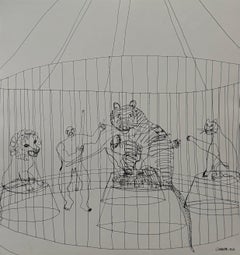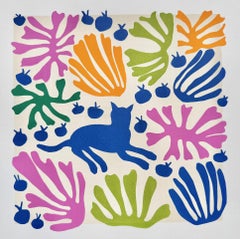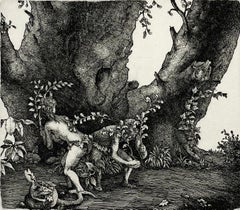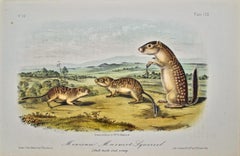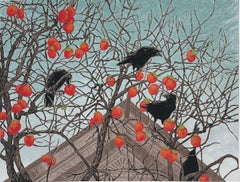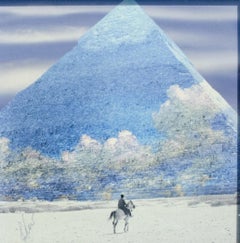Miniature Animal Prints
to
231
3,337
979
1,221
529
542
Overall Width
to
Overall Height
to
1,572
386
130
123
90
65
42
29
24
11
7
6
2
1
90
87
77
46
34
603
1,234
997
503
28
12
36
133
64
83
83
183
71
49
590
1,778
1,378
151
1,686
899
883
742
458
357
245
234
208
203
194
130
124
124
114
112
107
99
96
82
1,126
1,073
585
399
210
134
1,562
1,263
897
Size: Miniature
Alexander Calder Circus Reproduction Lithograph After a Drawing
Located in Surfside, FL
(after) Alexander Calder
"Calder's Circus" offset lithograph on wove paper after drawings by the artist
Published by Art in America and Perls gallery in 1964 (from drawings done in t...
Category
1930s American Modern Animal Prints
Materials
Lithograph
Matisse's Garden, contemporary, landscape, print, silkscreen
Located in Deddington, GB
Silkscreen
Image Size H 22 x 22cm
Framed Size H 47 x 45cm
Edition of 100
Additional information:
Screen print on Paper
Edition of 100
22 H x 22 W cm (8.66 x 8.66 in)
Sold unframed
...
Category
2010s Contemporary Animal Prints
Materials
Paper
Hiding From the Lord
Located in Palm Springs, CA
Adam and Eve hiding from the Lord (and hiding their nudity with branches) after being successfully tempted by the serpent that lays nearby watching the scene.
Signed, titled and num...
Category
1970s Contemporary Portrait Prints
Materials
Etching
Mexican Marmot Squirrel: Original 19th Cent. Hand-colored Lithograph by Audubon
Located in Alamo, CA
This is an original John James Audubon hand-colored lithograph entitled "Mexican Marmot Squirrel, No. 22, Plate CIX", from John James Audubon's Quadrupeds of North America, published...
Category
Mid-19th Century Naturalistic Animal Prints
Materials
Lithograph
Front Yard Persimmons, by Jos Sances
Located in Palm Springs, CA
A flock of blackbirds perch in a tree full of bright red persimmons, in front of the gable of a Victorian house.
Medium: Screenprint
Year: 2020
Image Size: 13 x 18 inches
Edition of...
Category
2010s Contemporary Animal Prints
Materials
Screen
Horseback Rider at the Great Pyramid of Giza, Surrealist Print
Located in New York, NY
Mystery Artist
Untitled (Great Pyramid), c. late 20th/early 21st century
Possibly C-Print or Lithograph?
Sight: 9 1/2 x 9 1/2 in.
Framed: 13 x 13 x 1 1/8 in.
Signed lower left
This...
Category
21st Century and Contemporary Surrealist Landscape Prints
Materials
C Print
Ancient Roman Fresco - Etching by Francesco Cepparuli - 18th Century
Located in Roma, IT
Ancient Roman Statue, from the series "Antiquities of Herculaneum", is an original etching on paper realized by Francesco Cepparuli in the 18th century.
Signed on the plate on the l...
Category
18th Century Old Masters Figurative Prints
Materials
Etching
Beagle, French hound dog chromolithograph print, 1931
Located in Melbourne, Victoria
French chromolithograph, published in 1931. Signed by artist in the plate. Printed title lower right of sheet. Plate number top right. From a French series of illustrations of sporti...
Category
1930s Art Deco Animal Prints
Materials
Lithograph
Print by Georges Manzana Pissarro 'La Bergère Turque' (The Turkish Shepherdess)
Located in London, GB
'La Bergère Turque' (The Turkish Shepherdess) by Georges Manzana Pissarro (1871-1961)
Etching
33.5 x 27 cm (13 ¼ x 10 ¾ inches)
Signed lower left, Manzana Pissarro, titled and inscri...
Category
1920s Post-Impressionist Animal Prints
Materials
Etching
Iceland or Gyr Falcon: An Original 1st Ed. Audubon Hand-colored Bird Lithograph
Located in Alamo, CA
This is an original rare first edition John James Audubon hand-colored lithograph entitled "Iceland or Gyr Falcon", No. 4, Plate 19 from Audubon's "Birds of America, lithographed, pr...
Category
Mid-19th Century Naturalistic Animal Prints
Materials
Lithograph
I'm the Real Thing Green - Signed Silkscreen Blue Dog Print
Located in Mount Laurel, NJ
This Blue Dog work consists of a dark green background with a blue dog with soulful yellow eyes sitting to the right of an old-fashioned style Coca-Cola machine. This pop art animal...
Category
2010s Pop Art Animal Prints
Materials
Screen
Percy Drake-Brookshaw (1907-1993) - 1971 Woodcut, Nine Lives 14
Located in Corsham, GB
This striking woodcut print depicts a cat cleaning itself in a compact, organic form. The artist's bold lines and contrasting use of light and shadow create a sense of texture and wa...
Category
Mid-20th Century Animal Prints
Materials
Woodcut
Percy Drake-Brookshaw (1907-1993) - 1971 Woodcut, Nine Lives 16
Located in Corsham, GB
This striking woodcut print features a seated cat, its body rendered in bold, expressive lines against a coloured background. The artist's skillful use of negative space and contrast...
Category
Mid-20th Century Animal Prints
Materials
Woodcut
Percy Drake-Brookshaw (1907-1993) - 1971 Woodcut, Nine Lives 6
Located in Corsham, GB
This striking woodcut print features a cat stretched out in repose, its body rendered in bold, expressive lines against a warm background. The artist's skilful use of negative space ...
Category
Mid-20th Century Animal Prints
Materials
Woodcut
Percy Drake-Brookshaw (1907-1993) - 1971 Woodcut, Nine Lives 14
Located in Corsham, GB
This striking woodcut print depicts a cat cleaning itself in a compact, organic form. The artist's bold lines and contrasting use of light and shadow create a sense of texture and wa...
Category
Mid-20th Century Animal Prints
Materials
Woodcut
Kurt Meyer-Eberhardt (1895-1977) - Framed Drypoint, The Young Foal
Located in Corsham, GB
A fine drypoint etching of a young foal by the famous German artist Kurt Meyer-Eberhardt (1895-1977). The print is a restrike created from the artist's original plate. Signed in penc...
Category
Early 20th Century Animal Prints
Materials
Etching
Percy Drake-Brookshaw (1907-1993) - 1971 Woodcut, Nine Lives 5
Located in Corsham, GB
This striking woodcut print features a cat stretched out in repose, its body rendered in bold, expressive lines against a warm background. The artist's skillful use of negative space...
Category
Mid-20th Century Animal Prints
Materials
Woodcut
HYBRID RABBIT - Contemporary / Photorealism / Animal print
Located in New York, NY
Original Giclee Print (Edition of 30) by Patricia Traub.
Patricia Traub (b. 1947, Allentown, PA) is a graduate of the Pennsylvania Academy of the Fine Arts and the York Academy of t...
Category
2010s Contemporary Animal Prints
Materials
Canvas, Giclée
Art Deco Landscape : The Bridge in Brittain - Original wooodcut, Handsigned
Located in Paris, IDF
Alfred LATOUR (1888-1964)
Art Deco Landscape : The Bridge in Brittain, 1928
Original woodcut
Handsigned in pencil
Numbered /160
On vellum 32.5 x 25.5 cm (c. 13 x 10 in)
Bears the bl...
Category
1920s Art Deco Animal Prints
Materials
Woodcut
Razorbill Auk, French antique natural history sea bird art illustration print
Located in Melbourne, Victoria
French chromolithograph, published in 1931. Printed title lower right of sheet. Plate number top right. From a French series of illustrations of birds.
195mm by 265mm (sheet)
Category
1930s Art Deco Animal Prints
Materials
Lithograph
Nude - Original Etching on Paper by Leo Guida - 1970s
By Leo Guida
Located in Roma, IT
Nude is an original black and white etching realized by Leo Guida.
Not signed.
The state of preservation is good. "INV.C. 161A", on the lower right margin.
Leo Guida: Artist sensi...
Category
1970s Modern Figurative Prints
Materials
Etching
Untitled
By Leonor Fini
Located in Barcelona, BARCELONA
Includes a Certificate of Authenticity
Category
1970s Modern Animal Prints
Materials
Lithograph
Leucippus Fallax (Buffy Hummingbird) — Original Hand-colored Lithograph
Located in Myrtle Beach, SC
John Gould, 'Leucippus Fallax' (Buffy Hummingbird), original lithograph with hand-coloring (not a reproduction), c. 1850. Signed in typeset 'J. Gould and H. C. Richter, del et lith.'...
Category
1850s Realist Animal Prints
Materials
Lithograph
'Digging for the Fox' & 'Death of a Fox'
Located in Stoke, Hampshire
James Seymour (1702-1752)
Digging for the Fox
Death of the Fox
A pair of Mezzotints
Image size 10 x 14 in
Framed size 12 1/2 x 16 1/2 in
James Seymour was an English artist renowned...
Category
18th Century Old Masters Animal Paintings
Materials
Mezzotint
Laying the Ghost by Orovida Pissarro - Animal etching
Located in London, GB
Laying the Ghost by Orovida Pissarro (1893-1968)
Etching
39 x 26.3 cm (15 ⅜ x 10 ⅜ inches)
Signed and dated lower right Orovida 1932 Numbered lower left 1/9 and titled lower middle
...
Category
1930s Animal Prints
Materials
Etching
The Physiognomy - The Bats - Original Etching by Thomas Holloway - 1810
Located in Roma, IT
The Physiognomy - The Bats is an original etching artwork realized by Thomas Holloway for Johann Caspar Lavater's "Essays on Physiognomy, Designed to Promote the Knowledge and the Lo...
Category
1810s Modern Figurative Prints
Materials
Etching
Bloodhound, early 19th century English dog engraving
By Philip Reinagle
Located in Melbourne, Victoria
'Blood Hound'
Copper-line engraving by J Scott (1774-1827) after Philip Reinagle (1749-1815), 1803.
Philip Reinagle was one of the best of the sporti...
Category
Early 19th Century Naturalistic Animal Prints
Materials
Engraving
Floral Portrait with Fur Hat on Black Background - Limited Edition Dibond Print
Located in FISTERRA, ES
"Floral Portrait with Fur Hat on Black Background" is a limited edition high-quality Dibond direct UV Print titled "Night in May With Hat". This piece, like the entire "Fetiches" ser...
Category
2010s Contemporary Portrait Prints
Materials
Metal
Untitled
By Leonor Fini
Located in Barcelona, BARCELONA
Includes a Certificate of Authenticity
Category
1970s Modern Animal Prints
Materials
Lithograph
Docket and His Bird Collection plate (Hand signed and inscribed by Tracey Emin)
By Tracey Emin
Located in New York, NY
Extremely rare when hand signed; the regular limited edition was not signed.
Tracey Emin
Docket and His Bird Collection plate (uniquely hand signed and inscribed by Tracey Emin), 20...
Category
2010s Pop Art Animal Prints
Materials
Ceramic
$4,900 Sale Price
30% Off
The Monitory Lizard, Australia, engraving with original hand-colouring, 1790
Located in Melbourne, Victoria
'The Monitory Lizard'
Copper-line engraving with original hand-colouring. 1790, by Frederick Polydore Nodder (fl.1770 – 1800).
120mm by 195mm (platemnark).
Early engraving of an ...
Category
Late 18th Century Naturalistic Animal Prints
Materials
Engraving
Playmates, mezzotint of child and cat by Cousins after Hugues Merle
By Samuel Cousins
Located in Melbourne, Victoria
Hugues Merle was a French painter who mostly depicted sentimental or moral subjects. Samuel Cousins was a highly regarded mezzotint engraver.
350mm by 2...
Category
Late 19th Century Victorian Figurative Prints
Materials
Mezzotint
Migratory Squirrel: An Original 19th Century Hand-colored Lithograph by Audubon
Located in Alamo, CA
This is an original John James Audubon hand-colored lithograph entitled "Migratory Squirrel, No. 7, Plate XXXV", from John James Audubon's Quadrupeds of North America, published in P...
Category
Mid-19th Century Naturalistic Animal Prints
Materials
Lithograph
Large Classical Bird Color Print after John James Audubon - Belted Kingfisher
Located in Cirencester, Gloucestershire
Classical Bird print,
after John James Audubon,
printed by Harry N. Abrams, Publishers, New York
unframed, 17 x 14 inches color print on pap...
Category
20th Century Victorian Animal Prints
Materials
Color
The Dove - Original handsigned black-manner etching - 100 copies
By Mario Avati
Located in Paris, IDF
Mario AVATI
The Dover
Original black manner etching
Handsigned in pencil
Numbered / 100 copies
On BFK Rives vellum 30 x 19.5 cm (c. 12 x 8 in)
Excellent condition
Category
1970s Modern Animal Prints
Materials
Etching
Mini Sea horse and Mini crab by Gavin Dobson, Limited edition diptych, Pop art
By Gavin Dobson
Located in Deddington, GB
Overall size - H42 x W29.6
Mini crab by Gavin Dobson [2021]
limited_edition
Cymk screen print
Edition number 100
Image size: H:21 cm x W:14.8 cm
Complete Size of Unframed Work: H:2...
Category
21st Century and Contemporary Contemporary Figurative Prints
Materials
Paper, Screen
Shepherdess and her Sheep - Original wooodcut, Handsigned & Numbered
Located in Paris, IDF
Henri AMEDEE-WETTER (1869-1929)
Shepherdess and her Sheep, 1920
Original woodcut
Handsigned in pencil
Numbered /105
On vellum 32.5 x 25.5 cm (c. 13 x 10 in)
Bears the blind stamp of...
Category
1920s Modern Animal Prints
Materials
Woodcut
Little Doll Portrait with Plants on Red Background. Limited Edition 25/25
Located in FISTERRA, ES
This a limited edition high-quality Dibond direct UV Original Print titled "Octombrina 25/25". This piece, like the entire "Fetiches" series, is inspired by the idea of biophilia and...
Category
2010s Surrealist Portrait Prints
Materials
Metal
Lizards, antique natural history reptile chromolithograph print, circa 1895
Located in Melbourne, Victoria
'Echsen I'
Lizards - chromolithograph from a German natural history series.
Key to lizards below the image.
Gustav Mutzel was a German artist famous ...
Category
Late 19th Century Victorian Animal Prints
Materials
Lithograph
Antique Hand Colored Copper Engraving "Saint Bernard Rescue Dogs"
Located in Douglas Manor, NY
6037 Antique watercolored copper engraving of a group of Saint Bernard rescue dogs
Framed
Image size 8x6"
Category
Early 20th Century Animal Prints
Materials
Watercolor, Engraving
Wild Wolves - Original Lithograph, Stamp Signature
Located in Paris, IDF
Pierre AMBROGIANI (1907-1985)
Wolves, 1974
Original Lithograph (Gourdon Workshop)
Signed with the artist's stamp
On vellum 38 x 28 cm (c. 14.9 x 11 in)
Excellent condition
Category
Mid-20th Century Expressionist Animal Prints
Materials
Lithograph
Bird of Prey: A 16th/17th Century Hand-colored Engraving by Aldrovandi
Located in Alamo, CA
This very rare, first edition, folio hand-colored woodcut engraving of a bird of prey is plate 219 from Ulisse Aldrovandi’s 'Opera Omnia', published ...
Category
Early 17th Century Naturalistic Animal Prints
Materials
Engraving
Barbara Hepworth's Cat & Matisse's Dogs in Love, diptych, contemporary, print
Located in Deddington, GB
Silkscreen
Image Size H 22 x 22cm
Framed Size H 47 x 45cm
Edition of 100
Additional information:
Screen print on Paper
Edition of 100
22 H x 22 W cm (8.66 x 8.66 in)
Sold unframed
...
Category
2010s Contemporary Animal Prints
Materials
Paper
Malabar Shrike, 18th century bird engraving by John Latham
By John Latham
Located in Melbourne, Victoria
Copper-line engraving. 1781. From John Latham's 'General Synopsis of Birds' 1781-1785, and its Supplements. Plate number top left. Laid paper.
John Latham was the leading English or...
Category
Late 18th Century Naturalistic Animal Prints
Materials
Engraving
White Weasel Sloat: An Original 19th Century Hand-colored Lithograph by Audubon
Located in Alamo, CA
This is an original John James Audubon hand-colored lithograph entitled "White Weasel Slout, No. 12, Plate LIX" from John James Audubon's Quadrupeds of North America, published in Ph...
Category
Mid-19th Century Naturalistic Animal Prints
Materials
Lithograph
Bullseye Black - Signed Silkscreen Blue Dog Print
Located in Mount Laurel, NJ
This Blue Dog work consists of a blue dog in the center of a red circle on a black background. The dog has soulful yellow eyes. This pop art animal original silkscreen print on pap...
Category
1990s Pop Art Animal Prints
Materials
Screen
The Untamed Bull - Original woodcut, Handsigned
Located in Paris, IDF
Honoré Broutelle
The Untamed Bull, 1922
Original woodcut
Handsigned in pencil
Numbered /154
On vellum 32.5 x 25.5 cm (c. 13 x 10 in)
Bears the blind stamp of the editor 'Imagier de ...
Category
1920s Art Deco Animal Prints
Materials
Woodcut
Nude Woman with Cat
Located in San Francisco, CA
This artwork "Nude Woman with Cat" c.1990, is an original colors etching with aquatint on Wove paper by noted Mexican artist Jose Esteban Martinez, b.1951. It is hand signed in penci...
Category
Late 20th Century Other Art Style Nude Prints
Materials
Etching, Aquatint
Shooting an African Buffalo, aquatint engraving hunting print, 1813
Located in Melbourne, Victoria
'Shooting an African Buffalo'
Colour aquatint by Mathew Dubourg (1786-1838) after Samuel Howitt.
From Samuel Howitt's 'Foreign Field Sports'. Samuel Howitt was an English painter, ...
Category
Early 19th Century Naturalistic Animal Prints
Materials
Aquatint
Western Swamphen, French antique natural history water bird art print
Located in Melbourne, Victoria
Porphyrion ou Poule Sultane - Western Swamphen
French chromolithograph, published in 1931. Printed title lower right of sheet. Plate number top right. From a French series of illust...
Category
1930s Art Deco Animal Prints
Materials
Lithograph
Eurasian Wigeon, French antique bird duck art illustration print
By P. Mahler
Located in Melbourne, Victoria
'Canard Siffleur'
(Eurasian Wigeon)
French chromolithograph, published in 1931. Printed title lower right of sheet. Plate number top right. From a French series of illustrations of...
Category
1930s Art Deco Animal Prints
Materials
Lithograph
Flamingo Engraving
Located in New York, NY
Original engraving, hand-colored at publication, after the work of Mark Catesby by Johann Michael Seligmann from "Sammlung verschneider auslandischer und seltener Vogel." Nuremberg:...
Category
Mid-18th Century Animal Prints
Materials
Laid Paper
"Nobility" 180/300 Signed Color Serigraph of Abstract Horse and Woman with Lute
Located in Austin, TX
Serigraph on paper
Page Size: 12 x 12 in.
Gold Leaf Frame Size: 21 x 21 in.
Hand Signed, bottom right in black marker
Hand Numbered, bottom left in black marker "180/300"
This strik...
Category
1990s Pop Art Animal Prints
Materials
Archival Paper, Screen
English Victorian 19th century people on a stage coach
Located in Woodbury, CT
Cecil Charles Windsor Aldin, was a British artist and illustrator best known for his paintings and sketches of animals, sports, and rural life. Aldin executed village scenes and rura...
Category
Early 1900s Victorian Figurative Prints
Materials
Lithograph
$1,000 Sale Price
20% Off
Floral Composition with Red and Pink Flowers. Biophilia. Limited Edition 25/25
Located in FISTERRA, ES
The original artwork, which marks the beginning of this original limited edition, is one of the early works from the series "Fetiches," created by Natasha Lelenco in 2021. The title ...
Category
2010s Contemporary Portrait Prints
Materials
Metal
Robert Marx, Blind Hunter
Located in New York, NY
German-born Robert Ernst Marx was a painter, printmaker, and teacher. His main subject was the human condition. This intaglio is somewhat unusual in ...
Category
1960s American Modern Figurative Prints
Materials
Intaglio
Blue Phases - Signed Silkscreen Print
Located in Mount Laurel, NJ
This Blue Dog work consists of a black background with the phases of the moon above a single blue dog sitting in the center. The dog has soulful yellow eyes. This pop art animal original silkscreen...
Category
1990s Pop Art Animal Prints
Materials
Screen
Diademed Sifaka - Original Lithograph by Paul Gervais - 1854
By Paul Gervais
Located in Roma, IT
Diademed Sifaka is an original lithograph on ivory-colored paper, realized by Paul Gervais (1816-1879). The artwork is from The Series of "Les Trois Règnes de la Nature", and was pub...
Category
1850s Modern Figurative Prints
Materials
Lithograph
At the Circus - Original wooodcut, Handsigned
Located in Paris, IDF
Robert BONFILS
At the Circus, 1927
Original woodcut
Handsigned in pencil
Numbered /160
On vellum 32.5 x 25.5 cm (c. 13 x 10 in)
Bears the blind stamp of the editor 'Imagier de la Gr...
Category
1920s Art Deco Animal Prints
Materials
Woodcut
Albatross - Etching by Johann Friedrich Naumann - 1840
Located in Roma, IT
Albatross is an Etching hand colored realized by Gotthilf Heinrich von Schubert - Johann Friedrich Naumann, Illustration from Natural history of birds in pictures, published by Stutt...
Category
1840s Modern Figurative Prints
Materials
Etching
Recently Viewed
View AllMore Ways To Browse
Le Singe Et Le Leopard
Leon Danchin On Sale
Louis Prang Chromolithograph
Man O War Horse
Manetti Saverio
Natural History Museum Vintage Prints
Penguin Lithograph
Peter Klucik
Pheasant Engraving
Picasso Dove Of Peace
Picasso Le Taureau
Picasso Rooster
Ronald Smith
Rooster Print Picasso
Salvador Dali Argus
Salvador Dali Unicorn
Sam Savitt
Shore Bird Print
